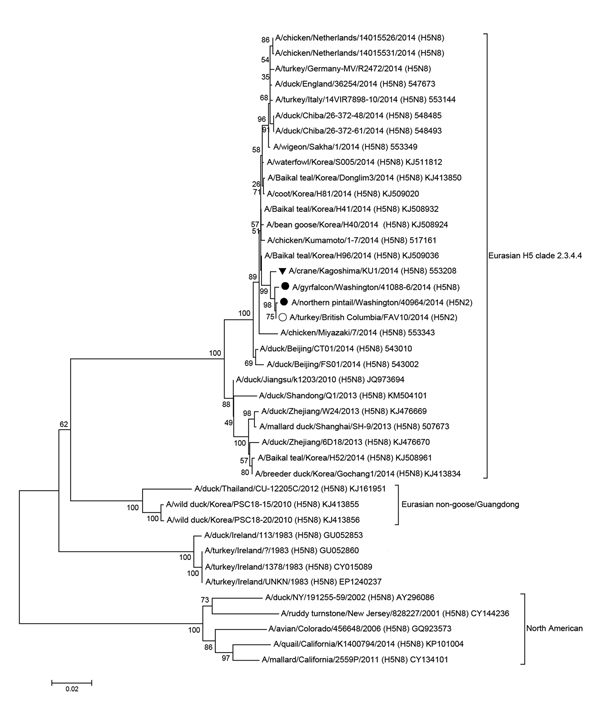Volume 21, Number 5—May 2015
Dispatch
Novel Eurasian Highly Pathogenic Avian Influenza A H5 Viruses in Wild Birds, Washington, USA, 2014
Figure 1

Figure 1. Phylogenetic comparison of the complete hemagglutinin genes of highly pathogenic avian influenza A(H5N2) and A(H5N8) strains from the United States with strains from Asia, Europe, and Canada. Solid circles indicate H5N2 and H5N8 strains from the United States; open circle indicates H5N2 strain from Canada; black triangle indicates H5N8 strain from a crane in Japan. Sequences were aligned by using MUSCLE, and phylogenetic and molecular evolutionary analyses were conducted by using MEGA version 5, using the neighbor-joining tree-building method, with 1,000 bootstrap replicates (10). Scale bar indicates nucleotide substitutions per site. Analysis was done with viruses that were phylogenetically representative of appropriate lineages (Influenza Virus Resource Database, http://www.ncbi.nlm.nih.gov/genomes/FLU/FLU.html).
References
- Kim Y-L, Pascua PNQ, Kwon H-I, Lim G-J, Kim E-H, Yoon S-W, Pathobiological features of a novel, highly pathogenic avian influenza A(H5N8) virus. Emerging Microbes and Infections. 2014;3:e75.
- Lee YJ, Kang HM, Lee EK, Song BM, Jeong J, Kwon YK, Novel reassortant influenza A(H5N8) viruses, South Korea, 2014. Emerg Infect Dis. 2014;20:1087–9. DOIPubMedGoogle Scholar
- Jeong J, Kang HM, Lee EK, Song BM, Kwon YK, Kim HR, Highly pathogenic avian influenza virus (H5N8) in domestic poultry and its relationship with migratory birds in South Korea during 2014. Vet Microbiol. 2014;173:249–57. DOIPubMedGoogle Scholar
- Zhao K, Gu M, Zhong L, Duan Z, Zhang Y, Zhu Y, Characterization of 3 H5N5 and one H5N8 highly pathogenic avian influenza viruses in China. Vet Microbiol. 2013;163:351–7. DOIPubMedGoogle Scholar
- World Organisation for Animal Health. Summary of immediate notifications and follow-ups–2014. Highly pathogenic avian influenza [cited 2014 Dec 14]. http://www.oie.int/wahis_2/public/wahid.php/Diseaseinformation/Immsummary
- Kang H-M, Lee E-K, Song B-M, Jeong J, Choi J-G, Jeong J, Novel reassortant influenza A(H5N8) viruses among domestic and wild ducks, South Korea, 2014. Emerg Infect Dis. 2015;21:298–304. DOIPubMedGoogle Scholar
- Olsen B, Munster VJ, Wallensten A, Waldenstrom J, Osterhaus AD, Fouchier RA. Global patterns of influenza a virus in wild birds. Science. 2006;312:384–8. DOIPubMedGoogle Scholar
- Bevins SN, Pedersen K, Lutman MW, Baroch JA, Schmit BS, Kohler D, Large-scale avian influenza surveillance in wild birds throughout the United States. PLoS ONE. 2014;9:e104360. DOIPubMedGoogle Scholar
- World Organisation for Animal Health (OIE). Avian influenza. Chapter 2.3.4. In: Manual of diagnostic tests and vaccines for terrestrial animals. Paris: The Organisation; 2014.
- Tamura K, Peterson D, Peterson N, Stecher G, Nei M, Kumar S. MEGA5: Molecular Evolutionary Genetics Analysis using maximum likelihood, evolutionary distance, and maximum parsimony methods. Mol Biol Evol. 2011;28:2731–9. DOIPubMedGoogle Scholar
- The Scientific Task Force on Avian Influenza and Wild Birds. Statement on H5N8 highly pathogenic avian influenza (HPAI) in poultry and wild birds [cited 2014 Dec 14]. http://www.ramsar.org/news/statement-on-h5n8-highly-pathogenic-avian-influenza-hpai-in-poultry-and-wild-birds
- United States Department of Agriculture, Food Safety Inspection Service. Recently revised export requirements [cited 2015 Jan 13]. http://www.fsis.usda.gov/wps/portal/fsis/topics/international-affairs/exporting-products/export-library-requirements-by-country
1These first authors contributed equally to this article.